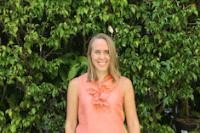| By Ruth Trego, Ph.D. candidate, University of Miami |
For my dissertation project, I’m trying to answer the question “During the 19th century, how did the United States reconcile its Western conception of what tropical spaces and tropical people are like with its adoption of tropical spaces within its own boundaries?” Conventional Western wisdom in the 19th century tended to teach that even though tropical places were beautiful and fruitful, that very fruitfulness led to laziness; Westerners believed that people who lived in lands where food grows abundantly would never have to get used to hard work. They also believed that hot climates led to hot passions, and that tropical inhabitants could never exercise the reason that those in more temperate climates cultivated.
What narrative strategies, then, did U.S. citizens use to bring tropical spaces—like South Florida and the Gulf Coast, for instance—into the country’s limits? Did they try to change the centuries-long narrative about the characteristics that such places brought out in people? Did they try to ignore that narrative? To think of the white people who moved into those spaces only as colonial officials while the nonwhite laborers there took on all the tropical associations? These are the questions that I hope to answer with the help of Gale Digital Scholar Lab and its extensive collection of American fiction. While I’m currently assembling a large corpus of over 15,000 texts from 1800‒1920, I’ve also run some demo tests with a smaller corpus of about 2,000 texts from 1880‒1920, and even these demos have shown some interesting results.
When I used the Gale Digital Scholar Lab topic modeling tool, I found that the corpus contains some useful tropical keywords. I used that information to dig into the contexts in which some of these keywords appeared. Early forays into a word like “swamp,” for instance, reveal that this word almost always connects to slavery in this corpus. If swamps come up in these texts, there’s an excellent chance that it’s in connection with a runaway enslaved person or as the place where an enslaved person died in an attempt to run away. This connection lends support to the hypothesis that many white U.S. writers probably continued to see many tropical spaces as the natural domain of nonwhite people and a dangerous place for themselves.
Just as “swamp” seems heavily connected to race in my early experiments, “tropical” as a general concept seems heavily feminized. It frequently describes a woman with a spirited, passionate temperament—often women of color, but sometimes also white women who spend time in hot places. This result is not surprising; ideas about temptresses from “savage” islands were popular in Western discourse. The persistence of this stereotype in the literature may indicate that white U.S. citizens were slow to put down their old stereotypes but eager to exploit them for sexually charged novels.
A final useful factor of these tools has been the ability to identify key texts of interest to me in my corpus. After I gather topics, I can then plug my corpus into a digital concordance and do a search for my most relevant keywords. For instance, a search of the word “tropical” revealed a small handful of texts that use this word with much higher frequency than most in the corpus. With this knowledge, I can seek out those particular texts for close reading if I decide I want to juxtapose a few specific texts against the picture of my corpus as a whole that the digital humanities tools will illuminate.
As most humanities projects that use digital methods tend to do, these initial results have really just opened up further questions for me. Practitioners of the digital humanities tend not to see this fact—that results just lead to more questions—as a negative, but rather as a prized benefit of digital humanities work. As Andrew Piper describes in his 2015 article “Novel Devotions,” this kind of work is an “iterative process” in which the results raise new questions, which in turn leads the researcher to seek out further results, and thus the cycle continues until the researcher has reached conclusions that resonate as satisfactory (and/or until the researcher runs out of time or funding).1 Gale Digital Scholar Lab has a commitment to continuously improve and add to their suite of available tools, and that allows me to complete this iterative process in a more centralized, cohesive environment than any I’ve worked with before.
1. Andrew Piper, “Novel Devotions: Conversional Reading, Computational Modeling, and the Modern Novel,” New Literary History, 46, no. 1 (2015): 63‒90.

Meet the Author
Ruth is a Ph.D. candidate at the University of Miami working on a dissertation about U.S. literature set in tropical locations. She has been the recipient of a UGrow fellowship at her institution and is currently a team member on the Mellon-funded project WhatEvery1Says. She enjoys teaching, experimenting with digital humanities tools and methods, and reading contemporary literature.

